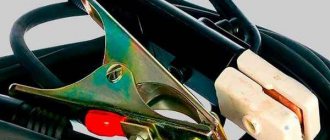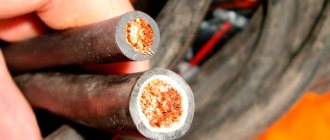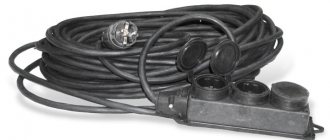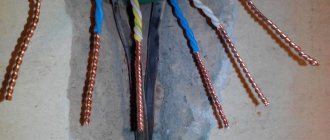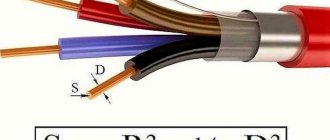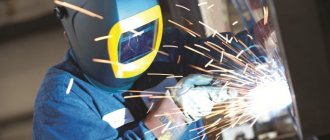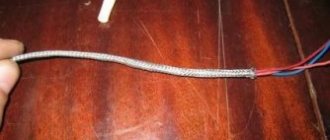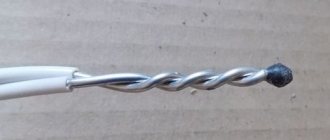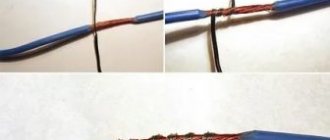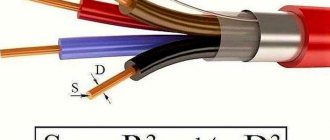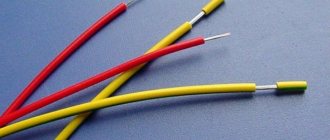Our modern world is a world of competition. The constant desire of manufacturers to reduce the cost of products leads to the fact that not the best, but the cheapest materials are installed on devices. Many of them do their job, but are either inconvenient to use, or the life of such raw materials is short-lived. The Chinese consider it unnecessary to equip inverter welders with long, thick wires. Usually the kit comes with short aluminum ones with a diameter of about 5 mm, which even when used with a three-millimeter electrode overheat and melt. Lightweight “crocodiles” also cannot withstand high current. How to replace factory wires will be discussed in our article.
Device
Of the available metals, copper serves as the best conductor .
Combined with its flexibility, this makes it an ideal material for making the base of welding wire - conductors. The structure consists of the following main parts:
- copper core, twisted from a large number of copper wires with a diameter of up to 0.5 mm;
- separating layer - a thin shell that prevents the core and the insulation layer from sticking together, can be supplemented with talc or other powder;
- an insulating coating consisting of rubber, rubber or other polymer.
The ends are provided with contacts to connect to the inverter and holder. They are crimped and soldered to ensure the best contact.
Characteristics
The most important characteristic required for a wire is its cross-section . It determines the maximum current passing through the cable. No less important is the resistance, which causes electricity losses on the way from the device to the electrode. Mechanical parameters are of great importance:
- strength: ability to withstand loads;
- elasticity: the ability to return to its original shape after deformation
- temperature resistance: the ability to maintain working properties when temperature changes;
- ability to withstand sunlight and humidity;
- resistance to fungus and mold;
The set of connecting welding wires supplied with the device corresponds to its permissible cross-section and length.
Kinds
With household and semi-professional class inverters, the most common in home workshops, single-core wires of the KG brand are mainly used.
Depending on their purpose and characteristics, they are:
- KG-HL , insulation is made of frost-resistant rubber, they work in the cold;
- KG-T , insulation impregnated with substances that prevent the growth of fungus and mold, used in humid climates
- KOG , highly flexible wires, for welding in hard-to-reach places, for example, in shipbuilding.
According to the number of cores they are divided into:
Single-core
Most of the inverter wires are single-core.
One wire connects the device terminals to the electrode holder, the other to the ground clamp on the workpiece.
Twin-core
Used for high frequency welding and alternating current operation . Two cores have their own insulation; the outside is covered with another insulating layer. Alloys of copper and other non-ferrous metals are used as materials.
Three-core
Such wires are used to connect automatic welding systems connecting pipelines and large containers.
Each core also has its own insulation.
Cable requirements for a welder
Firstly, if you choose a cable to connect the ground clamp and electrode holder to the welding machine, you need to consider the following operating features:
- Welding machines of any type produce significant currents - from 10-20 to 400-500A. At the same time, household inverter-type welding machines are usually designed for 200A with a deviation of 50A in each direction, and industrial welding transformers produce currents of 400A.
- A welder encounters a wide variety of tasks in his work, from simple seams in convenient positions to welding products of complex shapes or in hard-to-reach places.
- In addition to various tasks, you have to cook both in very hot rooms and in the cold in winter.
- To transport the equipment, the cables are rolled up.
It follows that the cable must meet the following requirements:
- The power welding cable must be flexible to ensure ease of manipulation of the electrode or torch for a semi-automatic welding machine.
- The conductor must have thick insulation and be resistant to aggressive environments, shocks and breaks.
- To work in cold conditions, the conductor must be frost-resistant.
- Welding of metals occurs with low voltage but high current, so there is a separate requirement for the cross-section of wires for connecting electrode holders and ground. This means that the wire must be thick to minimize voltage sags and losses.
- Must withstand repeated bending and winding/unwinding during transportation.
Section selection
The correctly selected welding cable cross-section for the inverter will allow you to work safely and with the expected performance. If the wire cross-section is insufficient, the resistance of the wire will cause loss of current due to its heating; as a result, the machine will not be able to develop the required welding current and the quality of the seam will deteriorate sharply. In this case, the indicator on the inverter will blink , indicating an overload.
Important! If you operate an overheated cable for a long time, the insulation and connection terminal may melt. This often leads to equipment failure and even fire.
In order to connect low-power portable inverters operating from a 220V network, light and flexible wires with a cross-section of up to 16 mm2 are used.
For more productive devices, a cross-section of up to 50 mm2 will be required.
Cable for connecting the welder to the network
In addition to connecting the electrode and ground to the welding machine, you also need a cable to connect the welder to the power supply. Regardless of what type of machine, inverter or transformer, the welding current reaches hundreds of amperes, but the supply current is much lower. It can reach about 30-50 Amps, depending on the power of the welder.
Therefore, to power it you do not need such a thick cable as for the electrode holder. It is calculated depending on the distance from the connection point to the power grid. If you have a single-phase household appliance of the inverter type at 220, or a two-phase transformer at 380V, then a copper conductor with a conductor cross-section of 2.5-4 kV, mm is suitable. Based on the number of cores, a two-core cable is used if there is no grounding at the site and a three-core cable if you are connecting to a grounded outlet.
For convenience, a network cable 3-5 meters long is enough, and for carrying around the site, use a carrier with a cross-section of 2.5 square meters. mm, if the carrying length is 10-20m. For reliable operation of the device from a longer carrying distance, for example 40-60 meters, it is better to take a cable with a cross-section of 4 square meters. mm.
If you are going to use a long carrier, it is better to buy an extension cord with a reel, then the cable will not get tangled under your feet and will last longer. However, in the coil it will not be cooled well, so that it does not overheat, it is better to take a cross-section with a margin.
For industrial three-phase 380V devices, four-core copper cables with a cross-section of 4-6 square meters are used. mm, or aluminum - with a cross-section from 16 sq. mm. Do not forget to check the correct connection and direction of rotation of the cooling fan, if present.
Correct connection
Proper connection ensures the welder productive and safe work.
Connecting wires to a welding machine requires compliance with a number of rules:
- there must be a terminal at the end, crimped or soldered;
- The wire cross-section must correspond to the maximum operating current of the device plus a margin of 20%
- You should carefully monitor the polarity of the connection and observe it;
- The cable must lie freely in the work area, without tension or loops.
How to connect a welding machine if there is not enough wire to the welding zone? You can increase its length.
Short welding cables: how, how much and what to extend?
A short welding cable is a problem. It becomes inconvenient to work; the lightweight inverter drags on the electrode holder, which, by the way, threatens its failure. In addition, getting somewhere to weld becomes problematic, and there is only one way out - to lengthen the welding cables.
On average, the length of the cables from the kit to the welding inverter does not exceed one meter. Often the cable comes in a low-quality sheath, which easily heats up and burns. As a rule, such cables are not enough for a long time even when welding purely at home.
Is it possible to extend the welding cable on the inverter?
When increasing the length, you need to understand that the longer the cable for connecting the welding inverter, the greater the losses and the lower the resulting current strength.
If it is necessary to weld at a great distance from the machine, wires of a larger cross-section should be connected to compensate for losses.
When splicing 380V cables equipped with terminals with a hole into a single circuit, they should be cleaned and securely connected with a bolt and nut, not forgetting to install large diameter washers. The connection point must be carefully insulated, taking into account the fact that the wire will be repeatedly pulled through metal and concrete.
How to connect an inverter if there is no crimped terminal on the cable? Wires are spliced by repeatedly interweaving the wires that make up the core . Then the connection point should be soldered and crimped.
V Abakumov, 5th category welder, Northern Shipyard: “I try not to lengthen the cable. For me, it’s easier to drag the device closer than to bother with braiding and crimping. In addition, the extended one is more likely to get caught and tangled, and there are large current losses on it.”
There are also special extension cables that have crimped and insulated connectors. Their type must match the connector of your device.
Important! Before connecting, all connectors must be thoroughly cleaned with scratch paper and degreased to improve contact.
Manufacturers do not specify any restrictions on cable length. In each case, the welder himself decides what is better - to lengthen or drag the inverter and gas generator more often .
What wires should be in the welding inverter?
The cable for the welding inverter is selected for the required load and possible operation. There are neither domestic nor imported universal cables for absolutely all conditions. However, many types are produced to suit any need.
The metal core must contain a large number of small wires - from tens to thousands. The cross-section of the core must correspond to the power of the device and the current of the electric arc. For example, for 2-3 mm electrodes, a current of 100 A is often sufficient. A good cable with a cross-section of 6 mm2 with a load resistance of up to 11 kW is suitable. More often, the welder produces more current, so the wire must be thicker.
Basic requirements for welding cables:
- Supply current to the welding surfaces with a minimum of losses.
- Be of sufficient length, weight, thickness. This ensures minimal heating with the possibility of remote operation without moving the device itself.
- Have reliable insulation of the conductor from environmental moisture.
- Have high wear resistance.
- Do not be affected by low temperatures. For example, when working in winter, rubber insulation marked KG or KG-HL must be selected. Moreover, the second operates at temperatures far beyond -35 degrees. PVC insulation is absolutely not suitable due to the inability to work at low temperatures and instability to ultraviolet radiation.
Cable markings:
- KS – welding.
- KG - flexible cable in single or double insulation.
- KG-HL is a flexible, cold-resistant cable for very low temperatures.
There are 3 types of conductors: with one, two, three cores.
- Single-core is typical for simple inverters and is more often used by garage mechanics.
- The two-wire connects the wires of the cathode and anode. The conductors are similar in design. The whole point of this design is the convenience of supplying high-frequency alternating current.
- Three-core is used in automatic welding of long metal structures. A larger number of cores gives a uniform, high-quality seam.
Sometimes in work it is necessary to extend the welding cable. This is done when working in cramped conditions or at heights, so as not to carry the device with you. Manufacturers do not speak clearly about the possibility of extending conductors. However, it was customary among welders that this should not be done. However, the cable length can be increased. The main thing is to remember that an extension of 1 m should correspond to an increase in cross-section by 40-50%. Otherwise, the conductor will begin to heat up uncontrollably, the welding arc will decrease, and it will become more difficult to control.
Marking of welding cables
The welding wire marking consists of several groups of letters and numbers. From it you can understand which model is in front of us.
First there are several letters indicating the type of cable.
After the type, a dash may indicate the climate class of the wire:
Next comes a number indicating the number of cores - 1, 2 or more. The designation is completed by the cable cross-section in mm2.
Safety requirements
When welding work, the following requirements must be observed:
- Do not work with wires with damaged insulation or insufficient cross-section;
- the wire in the working area should be placed freely, without clinging to the welder’s hands or feet;
- there must be enough light in the working area for the welder to move confidently;
- When connecting to the device, polarity must be observed.
Correctly selected wires for a welding inverter are the key to safe and productive work . You need to pay attention to the cross-section, length and climate class of the cable. Cable extension can be carried out in strict accordance with the requirements of the regulations.
